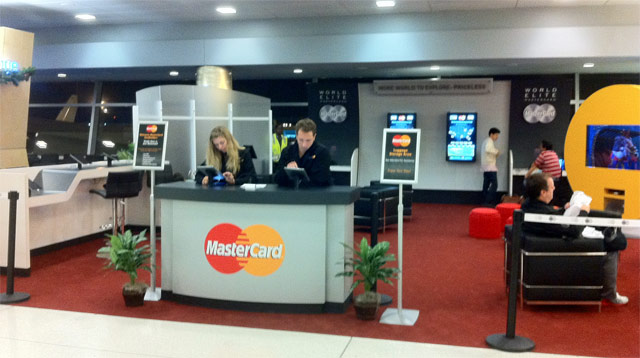Apple’s real iPad opportunity: Putting iPads where there weren’t PCs before
For many people, Apple’s iPad is a suitable PC replacement, and Apple is likely to see millions of iPad sales as PC substitutes. But Apple’s real opportunity — and probably why Apple thinks that the tablet market will eventually become bigger than the PC market — is for people to buy and use iPads where there weren’t PCs before.
Case in point: This MasterCard “lounge” in the American Airlines terminal at JFK airport — a roped-off area for MasterCard cardholders to sit on comfortable couches and chairs while they’re waiting for planes during the holiday travel season.

There is free power and wi-fi*, and a TV with an Xbox and Kinect games. And there are eight iPads set up for people to use. (Plus two iPads for the staff.) Four of the iPads are set up on swing-arms for people to use on the couches, including a selection of pre-installed apps. Four more are set up at a bench with stools.
In theory, some or all of these could have been PC laptops. But they aren’t. The iPad seems to make more sense in this case: It’s easy to use, easy to clean, easy to install, and easy to maintain. It looks cool, and has name-brand awareness. And it’s inexpensive: The $500 base unit is just fine for this purpose, and Apple may even offer large-scale “enterprise” discounts. (A company called Monscierge seems to be in charge of these.) So there’s ten iPads sold where there probably wouldn’t have been ten PCs sold.
And that’s just one “new” iPad use. There’s also the car-service driver I saw last night, waiting for his passengers at baggage claim holding an iPad “sign” with their name on it. (Higher startup cost, but no printing or markers required, no paper waste, a zillion other uses.) And the restaurant hostess using an iPad a few weeks ago to maintain the seating list, communicating with line-waiters via text message. And the lounge/restaurant of free-use iPads in the Delta terminal at JFK, which you can use to order food. Etc.
As far as Apple is concerned, the questions are:
- Is this a real, sustainable, long-term market, or just a fad? Will future MasterCard lounges or car service drivers use iPads for these purposes, or would they ever use Google Chromebooks, or something like that?
- Can Apple dominate this market — the iPad-as-public-device-and-sign-type-thing — or will it drift toward cheaper tablets, like the Nook Tablet, Kindle Fire, or no-name Android things?
Either way, it’s early, but Apple seems to have a promising start here.
*While I’m writing, a note on the experience in the MasterCard iPad lounge. It was… okay. It was great to have a free, comfortable couch and easy access to power outlets — don’t get me wrong.
The iPads existed, and they were connected to the Internet — sort of. Using parental (or enterprise?) controls, the iPads had been stripped of their Safari web browsers, so I could only use the built-in apps. There was no App Store access, so I couldn’t download more free apps, either. I assume this is to prevent people from looking at web porn on a comfy couch, or downloading fart apps. But this made the iPad pretty useless.
(It didn’t help, either, that the “free wi-fi” access for my iPad and MacBook Air didn’t exist, but supposedly they were going to figure that out.)
This is where some sort of iOS “guest mode” would be neat, to be able to sign into your iTunes account for a few minutes, download your favorite app or two, maybe a TV show from your iCloud library, access your email, and then sign out when you’re done and wipe your data off the device. This would also be useful when you’re visiting friends or relatives and want to access your stuff from their iPad.
In general, iOS doesn’t seem to be set up very well for sharing, and if the iPad is going to become a public-use device, it would be nice if Apple improved that experience.
But for now, accessing a limited-use, stripped-down iPad is better than nothing, I suppose.
Also: Will the tablet market really grow bigger than the PC market?

Check out my new site: The New Consumer, a publication about how and why people spend their time and money.

